This paper presents an AI planning approach for the automated composition of extract-transform-load (ETL) workflows to address the complexities and time-consuming nature of manually building such workflows in big data scenarios. The proposed workflow engine enables users to generate workflows by simply stating their intents, leveraging a domain-specific modeling language and focusing on improved accuracy, reduced expertise requirements, and faster turnaround times. Results from evaluations with real-world scenarios validate the effectiveness of the approach in automating ETL workflow generation.
![International Journal of Artificial Intelligence & Applications (IJAIA) Vol. 6, No. 5, September 2015
DOI : 10.5121/ijaia.2015.6501 1
AN AI PLANNING APPROACH FOR GENERATING
BIG DATA WORKFLOWS
Wesley Deneke1
, Wing-Ning Li2
, and Craig Thompson2
1
Computer Science and Industrial Technology Department, Southeastern Louisiana
University, Hammond, LA, USA
2
Computer Science and Computer Engineering Department, University of Arkansas,
Fayetteville, AR, USA
ABSTRACT
The scale of big data causes the compositions of extract-transform-load (ETL) workflows to grow
increasingly complex. With the turnaround time for delivering solutions becoming a greater emphasis,
stakeholders cannot continue to afford to wait the hundreds of hours it takes for domain experts to
manually compose a workflow solution. This paper describes a novel AI planning approach that facilitates
rapid composition and maintenance of ETL workflows. The workflow engine is evaluated on real-world
scenarios from an industrial partner and results gathered from a prototype are reported to demonstrate the
validity of the approach.
KEYWORDS
Workflows, Big Data, Extract-Transform-Load (ETL), AI Planning
1. INTRODUCTION
Workflows are increasingly important in the “big data” area of many scientific and industrial
problem domains. With the advent of the big data phenomenon, greater quantities of data are
being collected and shared [1][2][3]. Modern organizations have data continuously flowing into
their systems and seek solutions to continually re-evaluate this “big data” for real time decisions.
Through correctly applied data science techniques that correlate, filter, and transform collections
of data, these organizations can convert their raw data into knowledge that can be used to mine
actionable information.
As described by Deneke et al [4], traditional interfaces for workflow specification are manual,
time intensive and cumbersome (e.g. XML), requiring a whole new team of human users with
considerable domain knowledge to build, verify, and maintain solutions. The data is typically
fragmented, distributed among many different systems with differing schemas, quality, and stored
using different technologies. Further, the data often arrives raw; a mix of unstructured and multi-
structured data of poor quality that must be standardized and cleansed before it can be integrated
and utilized. As a consequence, manually building these workflows becomes a heavy investment
of time and resources.
The objective of our research is to address this rapidly rising cost by showing that ETL workflow
specification can be automated in an extensible manner through a domain-specific modeling
language. In order to effectively supplant the manual approach, an automated solution must
provide: better solution accuracy, lower required level of expertise, faster turnaround and fewer](https://image.slidesharecdn.com/6515ijaia01-191125111706/75/AN-AI-PLANNING-APPROACH-FOR-GENERATING-BIG-DATA-WORKFLOWS-1-2048.jpg)
![International Journal of Artificial Intelligence & Applications (IJAIA) Vol. 6, No. 5, September 2015
2
errors. Ultimately, our aim is to abstract the specification process, instead providing an intuitive
interface that flexibly integrates appropriate domain knowledge to enable even casual users to
generate the correct ETL workflow for their goals by simply stating their “intents”.
Our earlier work [5] presented preliminary results, but only provided an overview of two of the
key components of our approach: the knowledge representation and intent language. This paper
presents the details of the final component of our work: the workflow engine. The workflow
engine is an implementation of an AI planner that leverages the domain model to automatically
generate ETL workflows that satisfy the goals expressed through the intent language. The central
contribution of this research is generalizing database query languages to cover domain-specific
operators and developing a way to automatically map an intent query language to a workflow
plan. This enables users to focus on the goal statement (what they want to achieve) instead of
how to achieve the result.
The organization of the rest of this paper is as follows. Section 2 provides background and key
concepts associated with workflow, ETL, and how they relate to artificial intelligence planning
and database query languages. Section 3 presents a summary of our previous work and
introduces the AI planning approach employed by our workflow engine. Section 4 describes the
testing methodology, experimental results obtained, and evaluation of these results. Section 5
contrasts our approach with existing work in related disciplines. Finally, Section 6 summarizes
the conclusions and outlines areas of future research.
2. BACKGROUND
2.1. Workflow
Workflows play a central role in delivering ETL solutions, but are also used in a variety of other
areas, from AI planning and query optimization to web service composition and scientific data
processing. As defined by Aalst and Hee [6], a workflow models a process as a series of tasks
that must be performed to achieve a particular result. This model is commonly represented as a
directed graph (digraph). A directed graph G is defined as a pair (V, E), where V is a set of
vertices and E is a set of ordered pairs of vertices that denote directed edges connecting vertex
pairs. In this representation, vertices denote the tasks and edges specify the sequence in which
these tasks are performed.
A workflow can model a process at different levels of abstraction. A workflow’s tasks can
describe higher-level behavior or very basic actions. This is analogous to programming
languages, where high-level languages (e.g. C#) are easier to understand than low-level languages
(e.g. Assembly). While the abstraction of underlying actions makes high-level languages easier
to comprehend, this also provides users less control than low-level languages. To illustrate,
a)
b)
Figure 1. Workflow at: a) higher level of abstraction b) lower level of abstraction.](https://image.slidesharecdn.com/6515ijaia01-191125111706/75/AN-AI-PLANNING-APPROACH-FOR-GENERATING-BIG-DATA-WORKFLOWS-2-2048.jpg)
![International Journal of Artificial Intelligence & Applications (IJAIA) Vol. 6, No. 5, September 2015
3
consider the work performed by a person traveling from their home to the airport. Using high-
level descriptions, this process would consist of a task for preparing to leave the house followed
by a task for driving to the airport (see Figure 1a). While adding complexity, these tasks could be
broken down to describe the process in greater detail, such as in Figure 1b.
While a digraph can represent the composition of a workflow, this basic representation obscures
behavioral details, such as why the tasks must occur in this sequence. Instead, the result produced
by a data science workflow can be specified as a state: a specific set of conditions. Mapped as a
search space problem [7], workflow composition involves a sequence of state transitions
(imposed on the data by the operators) to attain the desired set of conditions (goal state). This
stateful mapping can be represented with a specific form of a digraph, known as a state diagram.
A state diagram S is a directed graph that can be formally defined as: S = (Q, ∑, δ, q0, F). In this
definition, Q is a collection of states, consisting of the start state q0 and each state qi depicted by a
vertex of the graph. F is a subset of Q that represents the set of accepting states. ∑ is a collection
of valid input symbols, also known as an alphabet. Finally, δ is a collection of state transitions,
where a state transition δi for the input symbol ∑t from state Qj to Qk is expressed as δi : ∑t × Qj →
Qk, and each state transition δi is depicted by an edge of the graph connecting the two states for
which there exists a transition. In the context of workflow, the vertices represent a workflow’s
distinct states and the edges represent the transitions between states dictated by the available
tasks.
To demonstrate this concept, consider the workflow depicted in Figure 2. For this example,
assume that the person starts at home and the goal is to end up at the airport. To achieve this
goal, the sequence of tasks performed in the workflow must transition the person from the initial
“At Home” state to the desired “At the Airport” state. The set of distinct states Q for this state
diagram representation can be defined as: Q = {Q1, Q2, Q3}, where Q1=“At Home”, Q2=“In the
Car”, and Q3=“At the Airport”. Similarly, the set of available tasks ∑ can be defined as: ∑ = {t1,
t2}, where t1=“Prepare to Leave the House” and t2=“Drive to the Airport”. The set of state
transitions δ can be defined as: δ = {δ1, δ2}, where δ1=Q1→Q2 and δ2=Q2→Q3, the start state q0=
Q1. Finally, the set accepting states F can be defined as: F = {Q3}.
2.2. Extract-Transform-Load Workflows
Extract-Transform-Load (ETL) refers to a category of data processing solutions that are designed
and executed as workflows to perform a series of extract, transform, and load operations on one
or more data sets. A data set is a collection of data records with a uniform schema. The schema
defines the data fields – elements that contain the instances of data – that data records are
comprised of. Each data field is assigned a data type and a name. The data type is a domain-
generic description of the values a data field can contain. The name is a tag – unique within a
given schema – that enables each data field to be individually addressed. This structure of data is
analogous to that of a relation in a relational database, where a relation contains tuples, which in
turn contains attributes.
Figure 2. A state diagram for a person traveling to the airport.](https://image.slidesharecdn.com/6515ijaia01-191125111706/75/AN-AI-PLANNING-APPROACH-FOR-GENERATING-BIG-DATA-WORKFLOWS-3-2048.jpg)
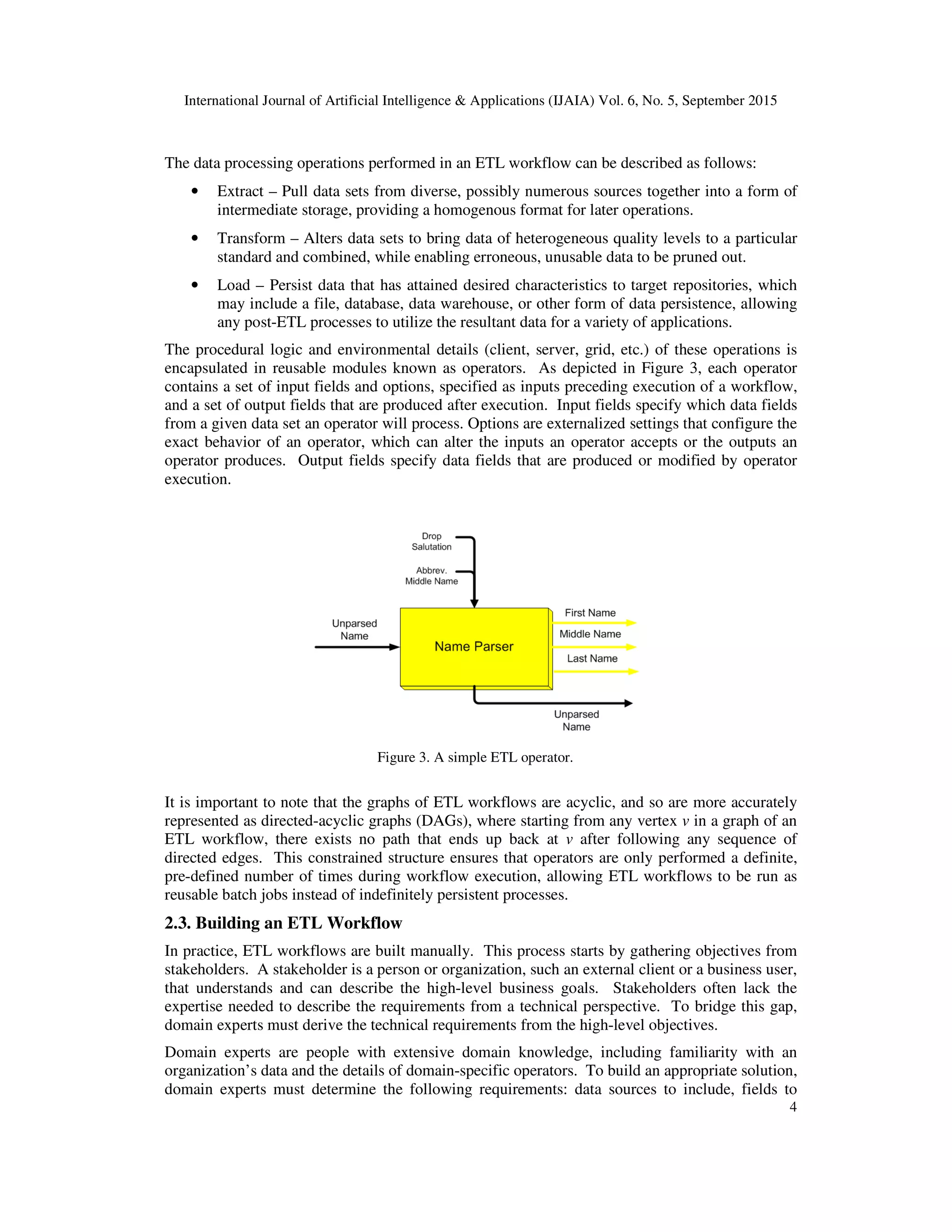
![International Journal of Artificial Intelligence & Applications (IJAIA) Vol. 6, No. 5, September 2015
5
extract from these sources, operators to include or exclude, field mappings, option mappings,
sequencing of the included operators, what fields to persist, and where to load the data for
persistence. These decisions can rely heavily upon domain knowledge. Numerous data fields
may appear to be valid arguments for input fields; some from the outputs of previous operators
and others from data sources. Further, several operators may perform similar operations;
requirements may necessitate that a custom operator is defined; some operators may need to be
performed in a specific order, while others can be performed at any time throughout the
workflow. Operator implementation can restrict the quality or format of input data, or
conditionally constrain the combination of inputs. Failure to conform to these assumptions can
cause the operator to error off or produce invalid results. A workflow’s composition may
similarly be subject to standards that have been put in place to ensure solution consistency, as
well as business rules that consider compliance with regulations or a domain’s preferred
practices. Once these questions are answered, the workflow graph, such as depicted in Figure 4,
can be constructed. Construction of the workflow graph is commonly performed using a visual
ETL tool. Commercial ETL tools available today include: IBM InfoSphere DataStage [8],
Microsoft SQL Server Integration Service [9], and Oracle Data Integrator [10].
Before a workflow is ready for production use it must undergo verification, where it is
methodically tested on sample data sets to ensure the workflow behaves according to the
specified requirements and verify absence of operator failures at run time from improper
mappings. Results produced by execution on sample data sets are evaluated to identify issues
such as: ambiguous or missing specifications, contradictory objectives, invalid input mappings, or
erroneous operator sequencing. Based on the evaluation, a workflow may need to be
reconstructed to resolve compositional errors or even revert back to the analysis phase to clarify
requirements.
2.4. SQL and Relational Algebra
Structured Query Language (SQL) is a declarative language, enabling those familiar with the
domain of relational databases to make clear, expressive statements in without needing to specify
sequences of relational operations or have knowledge of computer systems [11]. A user specifies
the properties of the data to be retrieved, not the algorithm required to retrieve the data.
Statements in SQL contain constructs known as operators, which perform a task involving one or
more relations and produce another relation as a result. Common SQL operators include select,
project, union, join, etc.
Figure 4. An ETL workflow.](https://image.slidesharecdn.com/6515ijaia01-191125111706/75/AN-AI-PLANNING-APPROACH-FOR-GENERATING-BIG-DATA-WORKFLOWS-5-2048.jpg)
![International Journal of Artificial Intelligence & Applications (IJAIA) Vol. 6, No. 5, September 2015
6
Before execution, SQL statements are parsed and translated into an intermediate procedural
language known as relational algebra, which is utilized by the query optimizer to find the fastest
executing expression for a given SQL statement [12]. Of particular interest is that the
intermediate form that high-level SQL statements are translated into is a kind of workflow,
known as a query plan. As in ETL workflow, operators in a relational query plan can be generic
or custom operations, such as relational algebra operators or user-defined functions respectively.
Similarly, the operands of these operators can be concrete or virtual relational tables, such as data
sources or outputs from earlier operations respectively.
2.5. Search and Planning
Search and planning are general approaches from artificial intelligence for automating problem
solving that are also complementary to automatic workflow generation. Similar to the earlier
observation that a workflow can be represented as a state diagram, search space concepts can be
mapped to workflow. As described by Coppin [7], the search space problem requires three basic
pieces of information: an initial state, a goal state, and the collection of available state transitions.
For a given problem, each choice can be represented as a state in a state-space diagram and would
include an initial state to indicate where the problem starts, and one or more final states to denote
the goals. A state transition represents making a choice, which changes the current state in the
state-space diagram to another state. Paths through the diagram that transition from the initial
state to the final states can then express problem solutions.
Constructing a workflow is a matter of constraint satisfaction (satisfying business rules, pre/post
conditions, pre/post requisites, etc.). Given constraint specifications, such as from a knowledge
representation, AI planning concepts can be employed to search for a solution to relevant
constraints and generate a workflow. The process of planning searches for a solution,
determining which actions should be performed to transition the current state closer to the goal.
STRIPS [13] is an example of an AI planner that employs an automated planning approach. The
approach follows a means-end analysis strategy, determining the differences between the current
state and the goal state, then selecting an appropriate action to move closer to the goal state. A set
of operators, each with preconditions and postconditions, represent the actions that can be taken.
From predicate logic [14], a precondition is a constraint that must be satisfied before a particular
action can be performed, while a postcondition is the “effect” of performing the action; what
becomes true and no longer true after performing the action.
An instance of STRIPS starts off given the following information: an initial state, described by a
set of true conditions; a set of conditions that describe the world; the set of available operators;
and a set of conditions that describe the goal state. The STRIPS program then develops a plan by
comparing the current world model to the conditions of the goal state. If these conditions match,
the goal state is reached and the problem is solved. Otherwise, an operator that lessens the
differences between the current state and the goal state is selected and added to the plan. Once an
acceptable plan is developed, the plan can be executed by the STRIPS robot and the goal
conditions should be satisfied.
3. APPROACH
3.1. Summary of Previous Work
3.1.1. Attributed Field Model
The attributed field model was introduced to express the characteristics of data, augmenting data
fields with two semantic annotations: content types and state attributes. These annotations are
semantic descriptions of concepts drawn from a domain’s ontology. The first annotation, content](https://image.slidesharecdn.com/6515ijaia01-191125111706/75/AN-AI-PLANNING-APPROACH-FOR-GENERATING-BIG-DATA-WORKFLOWS-6-2048.jpg)

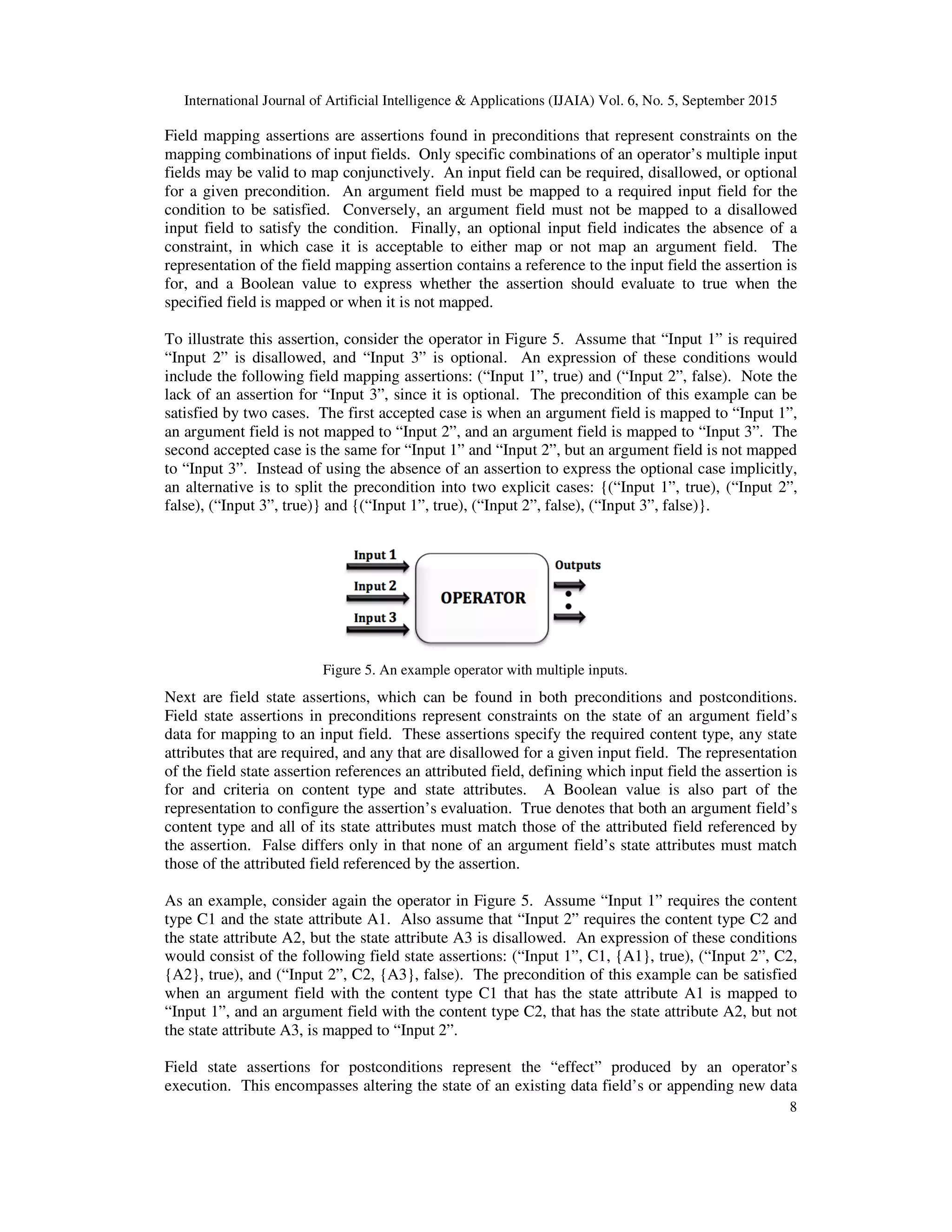
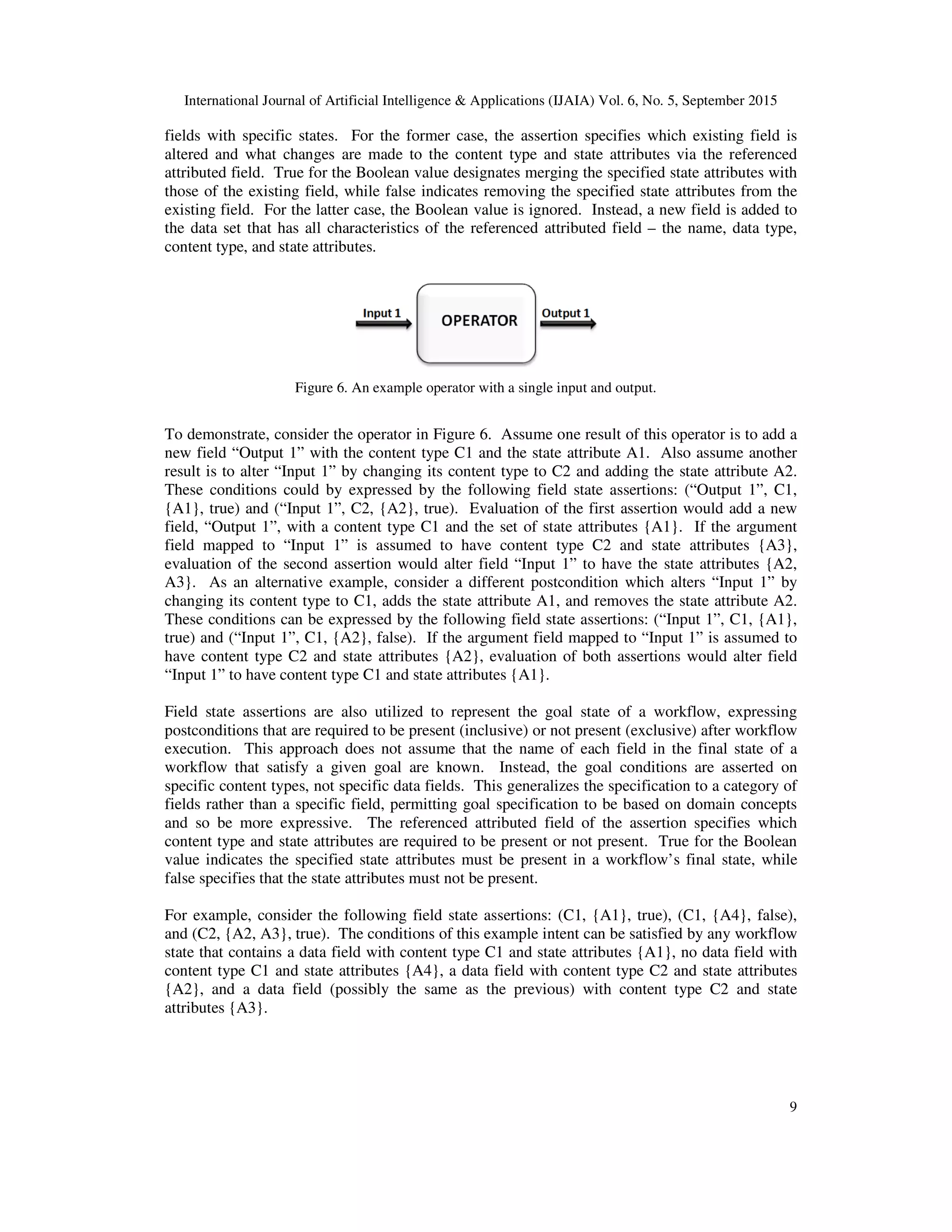
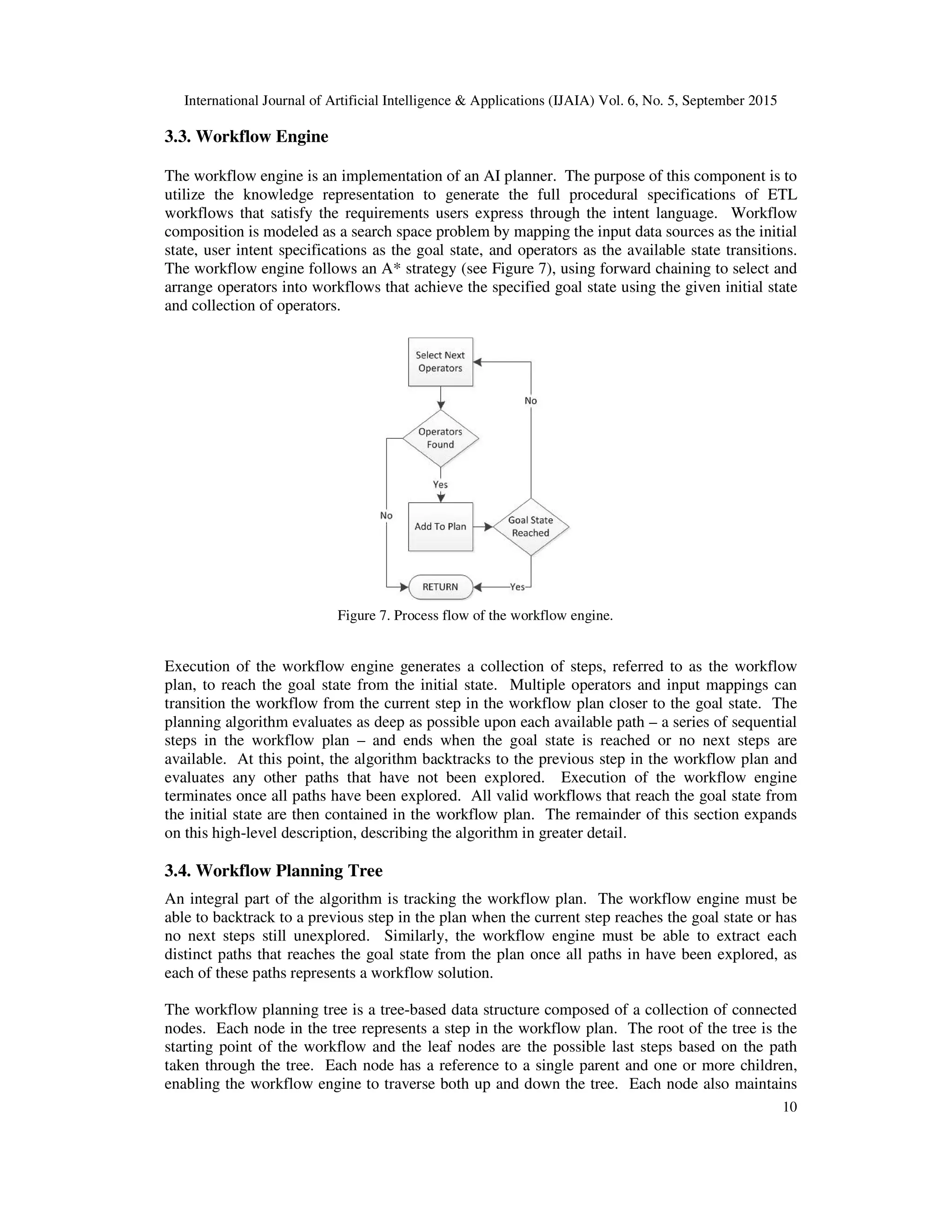
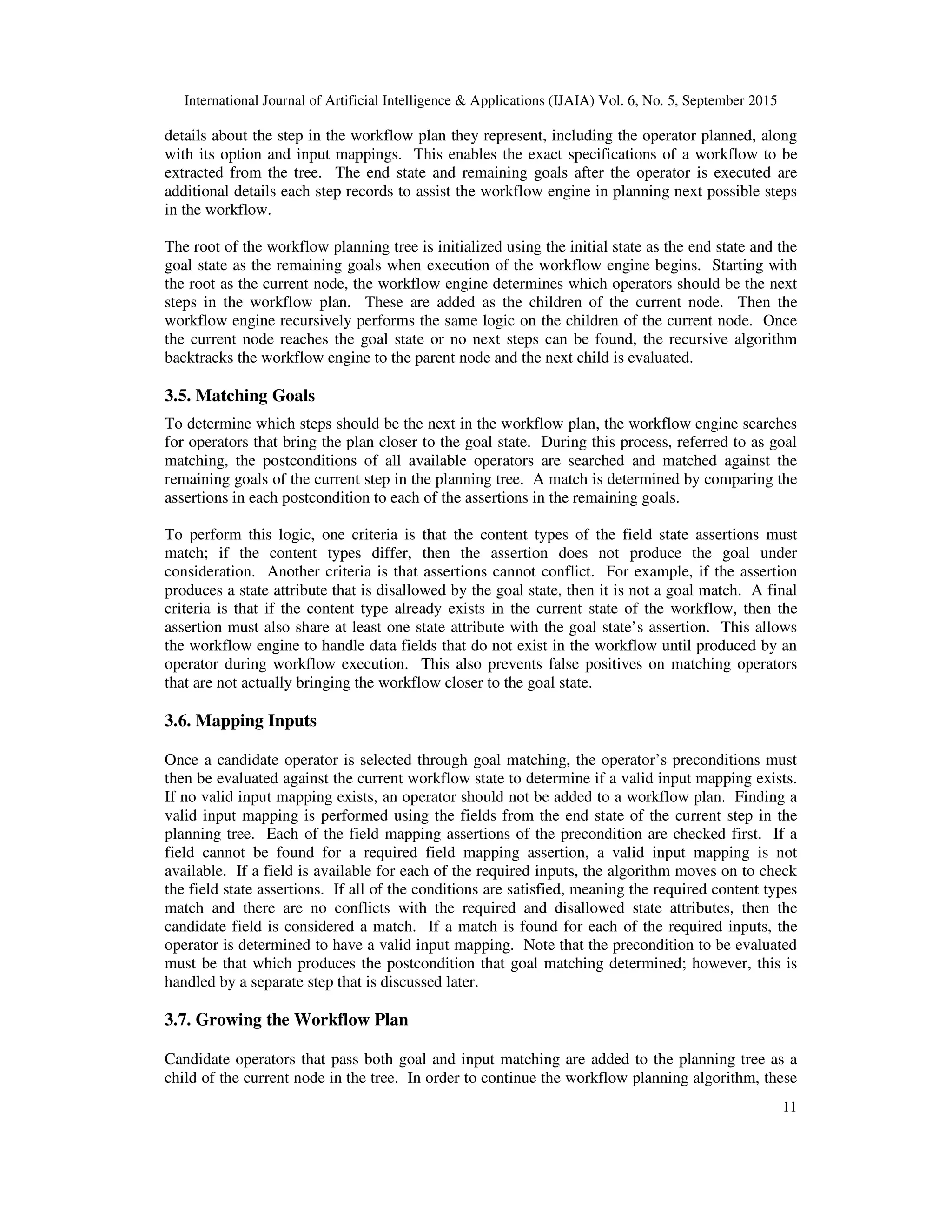
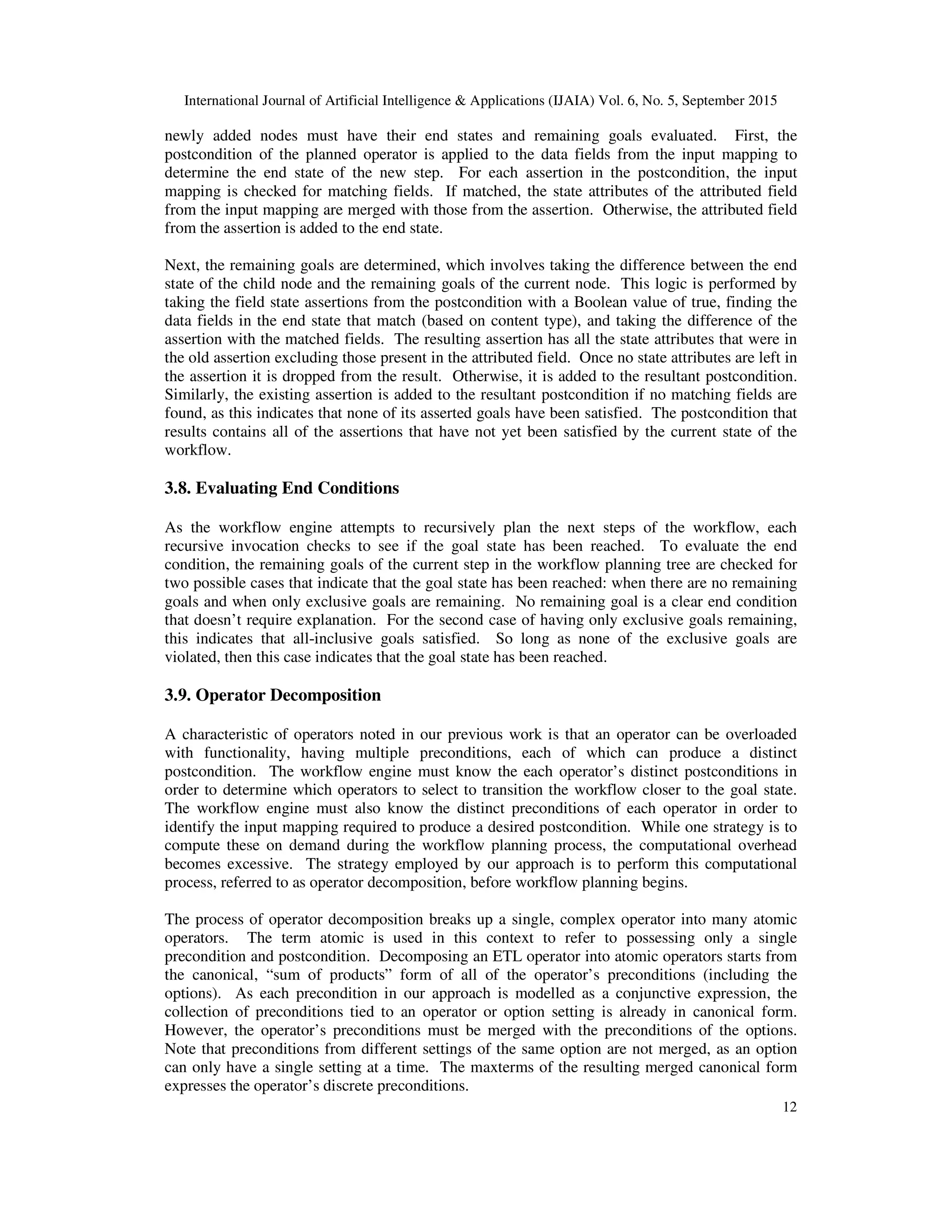
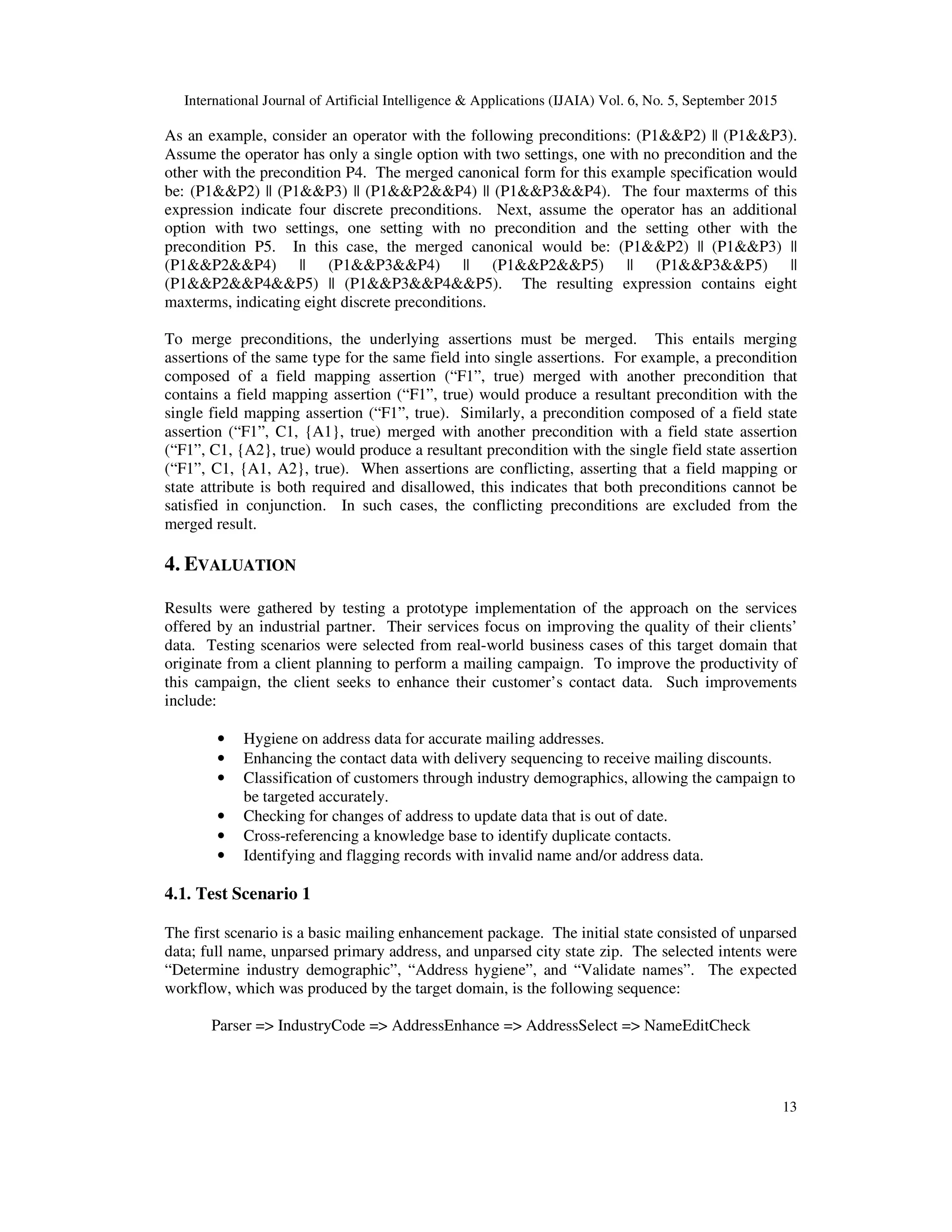
![International Journal of Artificial Intelligence & Applications (IJAIA) Vol. 6, No. 5, September 2015
14
4.2. Test Scenario 2
The second scenario is an advanced mailing enhancement package. As before, the initial state
consisted of unparsed data; full name, unparsed primary address, and unparsed city state zip. The
selected intents were “Determine industry demographic”, “Address hygiene”, “Link contacts”,
“Validate addresses”, and “Validate names”. The expected workflow – once again produced by
the target domain – is the following sequence.
Parser => IndustryCode => AddressEnhance => AddressSelect => ContactLink =>
NameEditCheck => AddressEditCheck
4.3. Results and Analysis
The number of workflows generated was 384 for the first scenario and 7680 for the second
scenario. Each workflow for the first scenario involved 5 operators, 8 options, 84 input fields that
had to be mapped, and 90 output fields. Each workflow for the first scenario involved 7
operators, 9 options, 116 input fields that had to be mapped, and 91 output fields. In the manual
process, the first scenarios would require 32,256 input fields and 3,072 options to map by hand,
and the second scenario would require 890,880 input fields and 69,120 option to map by hand.
Through our approach, however, solutions were generated automatically in less than one minute
for both scenarios.
Analysis of these solutions revealed only 16 distinct workflows in each scenario, all of which had
compositions matching the expected result and fulfilled the specified intents. The 16 distinct
compositions resulted due to the intents being under-constrained. Certain option settings were
ambiguous, thus multiple option configurations attained extraneous services as these were not
excluded by the goal specifications.
5. RELATED WORK
Relatively little literature exists that ties workflow as developed by the ETL community to
planning from artificial intelligence. The former community generates workflows manually,
while the latter automates plans that are, essentially, workflows. Some communities have
considered how the two areas can fit together, which is central to our work. The relational
community enables operations that involve data stored in relational databases to be expressed
through a high-level, declarative language, SQL. Statements in SQL are automatically mapped to
workflows known as query plans. However, a query planner is only able to map SQL statements
to generic set operations, not to custom operations. Query optimization also does not incorporate
domain knowledge, relying instead upon the expertise of the querying user.
Sun [15] recognized that the existing process to produce a workflow was “highly manual and
cumbersome effort” and sought to automatically generate workflows as a solution. The approach
employed a domain ontology to generate all possible workflows, then incorporated user-specified
constraints to filter the results until only a single solution was remaining. Our work differs in that
we constructively determine a solution for a given goal set instead of generating all possible
workflows and iteratively pruning the excess solutions through a decision tree.
Research by Zhang et al [16] employed patterns to capture and integrate domain knowledge from
experts. The approach associated these patterns with a task, scenario, and solution as an attempt
to provide domain independence. In contrast to our work, this research just makes suggestions
and does not fully generate workflows, leaving reliance upon domain experts in the specification](https://image.slidesharecdn.com/6515ijaia01-191125111706/75/AN-AI-PLANNING-APPROACH-FOR-GENERATING-BIG-DATA-WORKFLOWS-14-2048.jpg)
![International Journal of Artificial Intelligence & Applications (IJAIA) Vol. 6, No. 5, September 2015
15
process. Further, the approach cannot generate unique workflow solutions, merely regurgitate
what it has already seen.
Ambite and Kapoor [17] incorporated concepts of both domain ontology and artificial
intelligence planning. Their approach introduced predicate logic to represent domain knowledge
and employed a planner to generate a workflow solution for a given user request. The workflows
the planner was capable of building, however, were only a simplification of ETL workflow,
having only a single way to connect and sequence the available operators. Such an approach
would be infeasible to apply to domains with complex workflows.
Previous research by Xiao, Thompson, and Li [18][19][20] also employed a planner. This work
was capable of generating all of the possible workflows that transformed a given initial set of
input fields to a specified set of output fields. Though the research included a knowledge
representation, it was only able to capture a small portion of the domain knowledge. Constraints
on workflow composition due to operator logic, workflow standards, and business rules could not
be represented in an extensible manner. Consequently, even invalid workflows were included in
the solutions generated.
6. CONCLUSIONS AND FUTURE WORK
The scale of big data causes the compositions of data science workflows to grow increasingly
complex. With the turnaround time for delivering solutions becoming a greater emphasis,
stakeholders cannot continue to afford to wait the hundreds of hours it takes for domain experts to
manually evaluate and select an optimal workflow. The work presented in this paper introduces
an extensible approach to automatically transform declarative goal statements into fully-specified
ETL workflows. Like how query optimizers transform SQL statements into specific query plans,
our AI planning approach auto-generates workflows by following an A* search strategy to
sequence and connect operations that fulfill the requirements specified by a user’s intents. The
practical contribution is an intuitive interface that facilitates rapid composition and maintenance
of workflows, much like SQL provides for relational database queries. Results for real-world
industrial cases were gathered and analyzed to demonstrate (in a generative manner) the validity
of the approach.
There are several opportunities for further research in this problem area. Intelligent result
filtering is an enhancement that can improve ease of use, enabling ambiguous goals that inflate
the number of workflows generated to be identified and pruned by users for a refined result set.
Discovering interchangeable elements of workflow specification, analogous to identity statements
in query optimization, could revolutionize how businesses and scientists analyze and reason about
data science workflows, while opening the way for derivative research into optimization.
Optimization refers to the process of refactoring a workflow to improve it in some sense. For
instance, reducing the financial cost to the client, reducing the cost to the business in employee
hours, reducing the cost to the business in operations performed, or minimizing workflow
runtime. If equivalence relations are discovered for workflow operations, then workflows could
be optimized similar to query optimization, by transforming from one form to another that
produces the same result at a cheaper cost. These costs could be defined in a cost-model that
users can adjust to have particular factors weighed more greatly than others, including: runtime,
financial cost, and level of data quality.](https://image.slidesharecdn.com/6515ijaia01-191125111706/75/AN-AI-PLANNING-APPROACH-FOR-GENERATING-BIG-DATA-WORKFLOWS-15-2048.jpg)
![International Journal of Artificial Intelligence & Applications (IJAIA) Vol. 6, No. 5, September 2015
16
REFERENCES
[1] “XDATA,” DARPA Research Project Announcement, March 29, 2012.
[2] “Core techniques and technologies for advancing big data,” NSF Program Solicitation, March 29,
2012.
[3] President’s Council of Advisors on Science and Technology “Designing a digital future: federally
funded research and development in networking and information technology,” Report to the President
and Congress, December 2010.
[4] Deneke, W., Eno, J., Li, W., Thompson, C., Talburt, J., Loghry, J., “Towards a domain-specific
modeling language for customer data integration workflow,” GPC Workshops, IEEE Computer
Society, 2008, pp. 49-56.
[5] Deneke, W., Li, W., Thompson, C., "Automatic Composition of ETL Workflows from Business
Intents," Second International Conference on Big Data Science and Engineering (BDSE), Sydney,
Australia, December 3-5, 2013.
[6] Aalst, W., Hee, K., Workflow Management: Models, Methods, and Systems, MIT Press, Cambridge,
MA, March 1, 2004.
[7] Coppin, B., Artificial Intelligence Illuminated, Jones and Bartless Publishers, 2004.
[8] IBM Corporation, InfoSphere DataStage, URL: http://www-
01.ibm.com/software/data/infosphere/datastage/, Accessed: July 04 2015.
[9] Microsoft, SQL Server Integration Services, URL: http://msdn.microsoft.com/en-
us/sqlserver/cc511477.aspx, Accessed: July 12, 2015.
[10] Oracle Corporation, Oracle Data Integrator, URL:
http://www.oracle.com/technetwork/middleware/data-integrator/overview/index.html, Accessed: July
12, 2015.
[11] Chamberlin, D., Boyce, R., “SEQUEL: A Structured English Query Language,” SIGFIDET
Workshop on Data Description, Access, and Control (SIGFET ’74), New York, NY, 1974.
[12] Kifer, M., Bernstein, A., Lewis, P., Database Systems: An Application-Oriented Approach, Pearson
Education, 2006.
[13] Fikes, R., Nilsson, N., “STRIPS: A New Approach to the Application of Theorem Proving to Problem
Solving,” Artificial Intelligence, 2, (3-4), 189-208, 1971.
[14] Barwise, J., “An Introduction to First-Order Logic,” chapter in: Handbook of Mathematical Logic,
Chapter A.1, 6-47. Elsevier, Amsetdam, The Netherlands, 1977.
[15] Sun, T., “An Intelligent Wizard for Automatic Workflow Modeling,” IEEE International Conference
on Systems, Man, and Cybernetics, pp. 2742-2746, Taipei, China, October 8-11, 2006.
[16] Zhang, S., Xiang, Y., Shen, Y., Shi, M., “Knowledge Modeling and Optimization In Pattern-Oriented
Workflow Generation,” Twelfth International Conference on Computer Supported Cooperative Work
in Design, pp. 636-642, Xi’an, China, April 16-18, 2008.
[17] Ambite, J., Kapoor, D., “Automatic generation of data processing workflows for transportation
modeling,” Proceedings of the Eighth Annual International Conference on Digital Government
Research: Bridging Disciplines & Domains, Philadelphia, PA, May 20-23, 2007.
[18] Xiao, Z., Thompson, C., Li, W., “A Practical Data Processing Workflow Automation System in
Acxiom Grid Architecture,” International Workshop on Workflow Systems in Grid Environments
(WSGE06), Changsha, China, October 21-23, 2006.
[19] Thompson, C., Li, W., Xiao, Z., “Workflow Planning on a Grid,” Architectural Perspectives column,
IEEE Internet Computing, pp. 74-77, January-February, 2007.
[20] Xiao, Z., Thompson, C., Li, W., “Automating Workflow for Data Processing in Grid Architecture,”
International Conference on Information and Knowledge Engineering (IKE ‘06), Las Vegas, NV,
June 26-29, 2006.](https://image.slidesharecdn.com/6515ijaia01-191125111706/75/AN-AI-PLANNING-APPROACH-FOR-GENERATING-BIG-DATA-WORKFLOWS-16-2048.jpg)